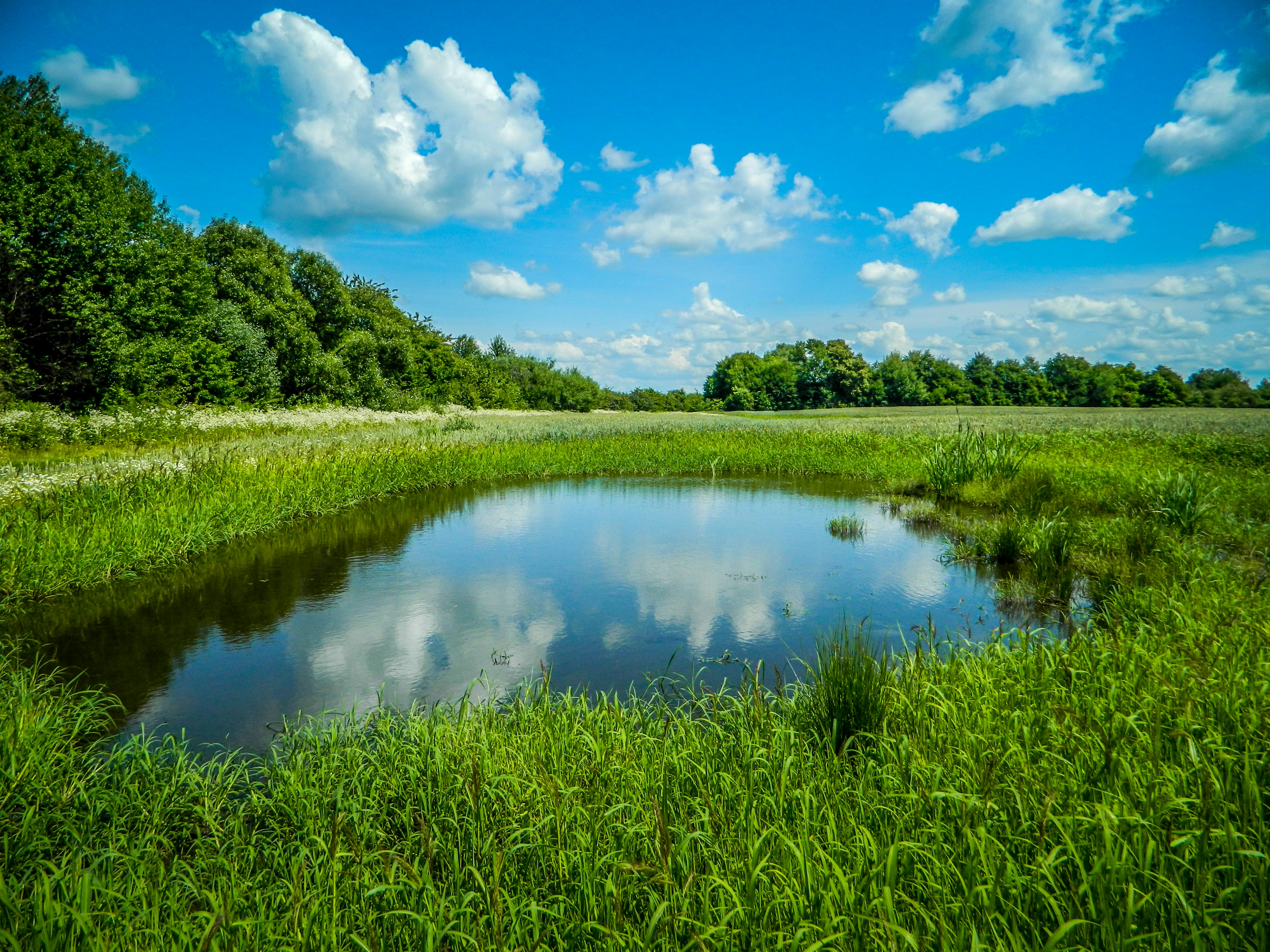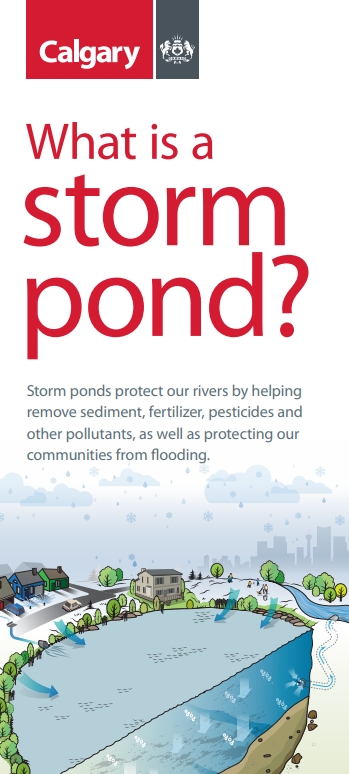Storm Ponds: Purpose, Safety, and Community Impact
In many of Calgary's newer communities, storm ponds have become a crucial component of urban water management. These ponds are designed to capture and hold stormwater runoff, including rainfall and snowmelt, before it reaches the city's rivers, creeks, and streams. While these storm ponds are essential for protecting our water systems and local environments, understanding their purpose, design features, and safety considerations is important for both residents and the local wildlife.
USE OUR QUICK NAVIGATION GUIDE BELOW TO JUMP TO ANY POINT OF THE IMPORTANCE OF STORM PONDS: 
- Flood Control
- Water Quality Improvement
- Ecosystem Support
- Types of Storm Ponds: Understanding Their Unique Roles
- Design Features
- Storm Pond Maintenance: Keeping Systems Running Smoothly
- Neighborhood Considerations: Impact on Children, Pets, and Community Safety
- Community Awareness
- Environmental Impact
- Conclusion
Purpose of Storm Ponds
Flood Control
Storm ponds are instrumental in managing stormwater runoff, preventing overflows that could lead to flooding in neighborhoods. During heavy rain or rapid snowmelt, stormwater accumulates on streets and properties. The storm pond acts as a temporary holding area, allowing water to collect and slowly drain away. By controlling the flow of water, storm ponds help reduce the risk of flooding, protecting both homes and infrastructure.
Water Quality Improvement 
As stormwater travels across streets and properties, it picks up pollutants such as oils, metals, bacteria, and fertilizers. Storm ponds capture and hold this runoff, allowing sediment and contaminants to settle out of the water. Over time, these ponds act as natural filtration systems, improving the quality of water that eventually flows into the city's rivers and streams. The slower release of water allows these pollutants to break down, reducing their impact on our water sources.
Ecosystem Support
Beyond their role in flood control and water quality, storm ponds contribute to the local ecosystem. These ponds provide vital habitats for various wildlife, including birds, amphibians, and aquatic plants. Native vegetation planted around the ponds helps prevent erosion and supports biodiversity. Shallow areas within the ponds allow certain species to thrive, making them an important ecological feature in urban environments.
Types of Storm Ponds: Understanding Their Unique Roles
Storm ponds come in various types, each designed to manage water flow, improve water quality, and prevent flooding in distinct ways. Here’s a closer look at the three main types of storm ponds you might encounter in your community:
Dry Ponds: A Temporary Storage Solution
Dry ponds are designed to remain dry for the majority of the time. These areas often double as recreational spaces, like sports fields or parks, where residents can enjoy outdoor activities. But when heavy rainfall strikes, dry ponds quickly fill with water. This feature helps keep stormwater systems from being overwhelmed, preventing the risk of flooding into basements, homes, or businesses.
To monitor water levels, dry ponds are often equipped with ultrasonic sensors that track the depth of the water. These sensors alert authorities when the pond begins to fill up, allowing for better management of water flow. After a rainstorm, these ponds can take up to 24 hours to fully drain, ensuring that the area’s drainage systems aren’t overburdened.
Wet Ponds: Constant Water Storage
Unlike dry ponds, wet ponds are designed to retain water year-round. These ponds play a crucial role in capturing stormwater over extended periods, allowing the water to slowly settle and undergo natural filtration processes. The stillness of the water enables sediment to drop to the bottom, and pollutants such as oils and chemicals can be broken down or filtered by natural processes.
Typically, wet ponds maintain a depth of around three meters, though this can rise quickly following storms. This helps to slow down the flow of water and prevent sudden surges of runoff that could otherwise overwhelm local waterways. Wet ponds help ensure that when the water is eventually released, it’s cleaner and safer for our rivers, creeks, and streams.
Constructed Wetlands: A Natural Solution to Stormwater Management
Constructed wetlands are artificial ecosystems that mimic the characteristics of natural wetlands. They’re designed to maintain appropriate water depths to support native plants and wetland-type soils, creating a unique environment where pollutants can be filtered and absorbed. These wetlands help remove harmful substances like fertilizers, pesticides, and other contaminants from the stormwater.
While the water in constructed wetlands is usually shallow before a storm, these ponds are built to manage high water levels during intense rain events. The vegetation within these wetlands plays an essential role in water purification and in creating a habitat for local wildlife. Constructed wetlands are a fantastic way to integrate natural solutions into urban stormwater management systems, helping both the environment and the community thrive.
Design Features
Inlets and Outlets
Storm ponds are equipped with inlets and outlets that control the flow of water. These systems are designed to manage the volume of runoff and prevent overflow, ensuring that the water is released in a controlled manner. By regulating water movement, these features also help reduce the erosion of pond banks and prevent sediment from being washed into other water systems.
Vegetation
Vegetation is a key feature in the design of storm ponds. Native plants are strategically planted to help stabilize the soil around the pond and reduce erosion. Additionally, aquatic plants such as cattails and bulrushes help improve water quality by filtering pollutants and providing oxygen to the water. This vegetative cover is essential for maintaining the health of the pond and supporting the local ecosystem.
Shallow Areas
Many storm ponds feature shallow areas that serve multiple purposes. These areas promote evaporation, helping to manage water levels and reduce standing water that can become a breeding ground for mosquitoes. Shallow areas also support specific plant and animal species that require these conditions to thrive.
Storm Pond Maintenance: Keeping Systems Running Smoothly
Storm ponds are designed to be low-maintenance systems, enhancing both the environment and surrounding communities. With the help of carefully selected plants, trees, and shrubs, these ponds not only maintain their integrity but also create habitats for a variety of wildlife species. Aquatic vegetation plays a key role in stabilizing the pond's ecosystem, helping to filter water and reduce erosion.
However, even the most well-designed storm ponds require occasional upkeep to ensure they continue to provide essential benefits. Below are some of the key aspects of storm pond maintenance that help ensure these water features remain functional and safe for the environment.
Sediment Build-up and Removal
As stormwater flows through the pond, it naturally carries sediment, debris, and pollutants. Over time, these materials settle in the pond, helping to clean the water before it is released into rivers and streams. While this is a vital process, the accumulation of sediment can affect the pond’s storage capacity and the overall quality of the water. Regular sediment removal is necessary to ensure the pond can continue to function efficiently and prevent negative environmental impacts downstream.
Managing Algae Growth
Algae are a natural part of storm pond ecosystems. They help improve water quality by consuming excess nutrients and trapping contaminants before the water flows into larger water systems. In the Calgary area, a common form of algae called Cladophora appears as stringy, fibrous mats on the surface of storm ponds. While it’s usually harmless and poses no safety concerns to humans, animals, or birds, excessive algal growth—especially during warm, dry weather—can lead to unsightly blooms and sometimes unpleasant odors.
Algae blooms can be triggered by various factors, including prolonged warm weather, fertilizers from nearby lawns, and decaying organic matter. Local authorities, like the City of Calgary, closely monitor algae levels and respond to public concerns to ensure the ponds remain healthy. Excessive blooms are managed by the city when needed, taking action to maintain the pond’s water quality.
Dealing with Odors
Odors from storm ponds can occur due to the natural decay of organic matter, especially during the colder months when ice forms on the surface. As the ice melts in the spring, gases that have been trapped under the ice are released, creating temporary smells. While the odor may be unpleasant and even alarming, it typically does not pose a risk to public health or the environment. In cases where the odor is strong or smells similar to natural gas, authorities investigate immediately. However, in most cases, the odor is a normal part of the seasonal process and disperses once the water in the pond fully mixes.
Preventing Invasive Species
It is crucial for the health of storm ponds and the surrounding ecosystem to prevent the introduction of invasive species. Certain fish, such as goldfish and Prussian carp, are often illegally stocked in storm ponds. These species are not native to Alberta and, without natural predators to control their population, they multiply rapidly. If invasive species like these reach nearby rivers, they can disrupt local habitats, out-compete native species, and spread diseases.
The release of non-native fish into storm ponds is illegal and carries significant penalties, including fines of up to $3000. To help preserve the integrity of storm ponds, it is important to dispose of unwanted fish properly by taking them to pet stores or burying them when they pass away—never flushing them down toilets or releasing them into ponds.
By understanding the key aspects of storm pond maintenance and the natural processes that occur, residents can help protect these important community resources. Regular upkeep, algae management, sediment control, and invasive species prevention ensure that storm ponds remain a valuable asset to urban stormwater management systems.
Neighborhood Considerations: Impact on Children, Pets, and Community Safety
Children and Pets Safety
Storm ponds, while designed for environmental and flood management, also present unique safety challenges, especially for families with children and pets. It is crucial that neighborhood residents understand both the safety features and the community guidelines around these water systems to ensure everyone stays safe and that the ponds continue to function as intended.
Storm ponds often appear inviting, especially to curious children and pets, but they can present hidden hazards. The water in storm ponds can be much deeper than it appears, and the banks may be slippery, posing a risk of slips or falls. The strong current and sudden changes in water depth can also be dangerous, especially after a storm.
To keep children and pets safe, it's important to:
- Keep a close eye on young children and pets when near storm ponds.
- Follow local guidelines for storm pond access restrictions, which include fences or signs to limit access.
- Avoid allowing pets to drink or play in the water to reduce the risk of illness from pollutants or contaminants.
- Educate your children about the dangers of playing near storm ponds and why they should never attempt to swim or play in the water.
.png)
Keeping the Neighborhood Safe
In addition to individual safety, community cooperation plays a vital role in maintaining the safety of storm ponds. Residents should report any damage to fencing or barriers that could allow access to these dangerous areas. Regular community checks and neighborhood involvement in keeping the ponds clean and properly maintained can reduce the likelihood of accidents. It’s also important to avoid feeding wildlife around storm ponds, as it can disrupt the ecosystem and lead to more human-wildlife interactions.
Caring for the Community's Stormwater System
A healthy storm pond benefits the entire neighborhood. Residents can contribute to the effectiveness of these water systems by:
- Properly maintaining their own yards to reduce runoff and prevent pollutants from washing into the stormwater system.
- Not dumping any chemicals, waste, or pet waste near storm ponds to protect both the environment and water quality.
- Avoiding the release of fish or other non-native species into the ponds, as this can disrupt the local ecosystem and cause long-term damage.
Community Awareness
Educational Programs
In Calgary, educating the community about the purpose and benefits of storm ponds is essential for fostering appreciation and care. Local programs inform residents about how storm ponds help with flood control and water quality, as well as the role of vegetation and wildlife in supporting healthy ecosystems. Understanding how storm ponds contribute to a safer, cleaner environment encourages responsible behavior in and around these areas.
Reporting Issues
Community involvement is key to keeping storm ponds functioning properly. Residents are encouraged to report any safety concerns, pollution, or signs of damage to local authorities. By reporting issues such as illegal dumping, damage to fencing, or water quality concerns, the community helps ensure that storm ponds remain safe and effective.
Environmental Impact
Biodiversity Promotion
Storm ponds support biodiversity by providing habitats for a variety of species, including waterfowl, amphibians, and aquatic plants. These ponds act as important wildlife sanctuaries, helping to sustain local ecosystems even in urban environments. By preserving these habitats, we are contributing to the overall health of the surrounding environment.
Stormwater Management
Effective stormwater management is critical for maintaining water quality and reducing erosion in urban areas. Storm ponds help prevent excessive runoff from overwhelming natural water systems and reduce the impact of urbanization on rivers, creeks, and streams. By capturing runoff, filtering pollutants, and slowing down water flow, storm ponds protect both the environment and our water resources.
An Essential Role
Storm ponds play an essential role in managing stormwater, improving water quality, and supporting local ecosystems. Understanding their purpose, design, and maintenance is crucial for the well-being of both urban communities and the environment. By staying informed and involved, residents can help maintain the effectiveness and safety of these important structures, ensuring that they continue to benefit future generations.

Dusko Sremac – Calgary Real Estate Expert
With over 1,500 Calgary families served, Dusko Sremac brings trusted expertise to both homebuyers and investors navigating suburban and rural communities. His deep knowledge of Calgary’s infrastructure—including storm pond regulations, environmental zoning, and community development—helps clients make informed real estate decisions that balance lifestyle, safety, and long-term value. Whether you’re buying near new developments or looking for homes close to nature, Dusko’s local insight ensures you're always a step ahead.



Leave A Comment